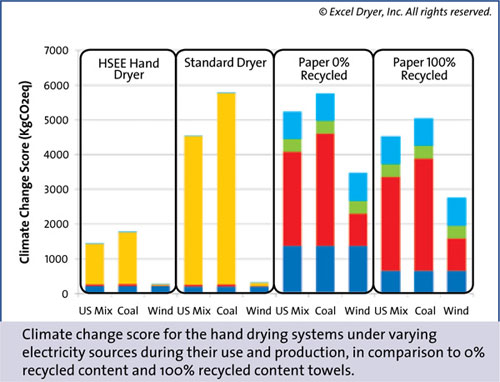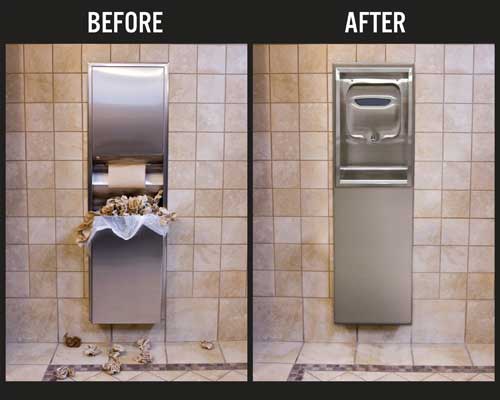Throw in the Towel: High-Speed, Energy-Efficient Hand Dryers Win Hands Down
Source of Electricity
Sensitivity tests on the source of electric power provided minor reductions in the relative differences among the three systems' environmental impact scores, but the HSEE dryer remained the vastly more sustainable choice, regardless of power source. The issue with electric power is determining which source of power will provide the short-term power demanded by a hand dryer. Should the average of all electrical power sources in the US be used (which includes some renewable sources) or should you 'penalize' the hand dryer, and assume all of the short-term power demanded would come from fossil fuels (coal or natural gas) and totally exclude renewable sources, since renewable sources cannot inherently respond to a demand spike, regardless of how small it may be. In either case, the HSEE dryers produce a lower environmental impact score. Interestingly, the paper towel systems use 75-80% as much electricity over its life cycle as the HSEE dryer so a change in electricity source does very little to change the comparison among the systems' environmental impacts. And when you add in the other impacts of the paper towels themselves - pulp, bleaching, packaging, transporting, and disposal, paper towels end up with a much more negative environmental impact, according to this peer-reviewed LCA.

Alternatively, in the unlikely event of a change to wind-power occurred, it would improve the environmental impact of all three systems. For both electric hand dryers, their climate change scores would be reduced by 80-95%. The paper towel system would see its climate change impact reduced by about 1/3, since its impact is only partially dependent on electricity use and pulp production, packaging, transportation, and disposal also add to its climate change impact. But if all systems have the same benefit, they stay in their relative positions, with the HSEE hand dryers being the best environmental choice in this scenario as well.
Double-check Midpoint Impact Indicators
"Some manufacturers are offering product enhancements to address concerns for sound-sensitive areas. Examples include an air speed controller that adjusts the speed and sound level of the dryer and noise reduction nozzles – both options are retrofittable and can help significantly reduce the dryer's decibel level." |
The rigor of LCA is re-doubled by employing a second assessment methodology-in this case, TRACI (Tool for the Reduction and Assessment of Chemical Impacts). This two-fold assessment methodology confirmed that the HSEE hand dry solution is "the lowest scoring system on each criteria evaluated, often by a wide margin" when using a wide variety of midpoint-level environmental indicators.
From a quantitative perspective, the complete LCA document has a detailed table for each hand drying system that shows the LC Inventory items and their respective impacts on each of the fiveendpoint or damage categories under the baseline scenario.
 |
ADA -compliant stainless steel paper towel dispenser retrofit kits provide a simple, cost-effective solution for replacing built-in paper towel dispensers with high-speed hand dryers. Photo © Excel Dryer, Inc. All rights reserved. |
Comparison with Prior Study Results
As an ISO 14040 compliant LCA, this study examined the results of previous studies (conducted by others) for consistency and also analyzed those study results to explain any differences. As testing and measurement techniques improve, Life Cycle Inventory databases become more complete and accurate, and advancements in products and processes become more sophisticated and environmentally beneficial, prior studies loose their efficacy for comparison purposes with current LCAs.
Study Limitations
Life Cycle Assessors, like Quantis, assess the quality and consistency of the information used to support the results of the study. In this study, noted limitations - disposal of batteries and the process of producing recycled pulp from used paper - form a top the "To Do List" for future study by someone. Both of these limitations would likely result in greater impacts for the paper towel system, and therefore, they would not change the direction of the LCA's conclusions. The interaction between the heat discharged from the hand dryers and each buildings HVAC system is another issue, but it is so complex - with multiple climates, time of use and whether the building is being heated or cooled, etc. - it is beyond the scope of this study. This study was focused on the United States but it would be useful to new full assessment would be warranted for countries where renewal energy, for example is a higher percentage contributor the power source total.









